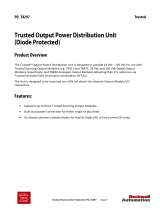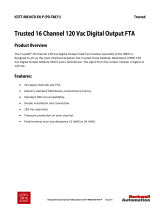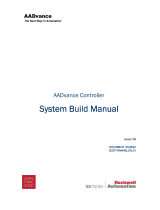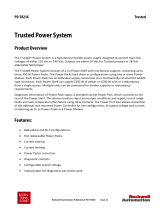Page is loading ...

PD-T8444 Trusted
Rockwell Automation Publication PD-T8444 Issue 10
Trusted TMR Pulse Generator and Monitoring
Module
Product Overview
The Trusted® Triple Modular Redundant (TMR) Pulse Generator and Monitoring Module interfaces
through special Thyristor Drivers, to two Stepper Motors, which form an integral part of a damper
rod control system. The Module is based upon the Trusted T8461 Digital Output Module. Feedback
of Thyristor activation and rod position is provided by the Module as a % movement figure and a
series of fault signals. Triplicated diagnostic tests are performed throughout the Module in order to
locate and annunciate hardware failures. Inputs are treated as analogues and are fully tested by the
nature of their operation. Fault tolerance is achieved through a TMR architecture within the
Module.
The Module has been configured to provide the control and interlock requirements for a high
power stepper motor control system which is used to position Damper Rods in a Nuclear reactor.
The functionality of this Module is highly specialised and is detailed later in this Product Description
(PD).
Features:
• Two Stepper Motor controls.
• Special control algorithms and fault diagnostics resident within the Module.
• Bi-directional fast and slow movement.
• Emergency stop and hold facility.
• Rod position indication.
• Thyristor driver fault indications.
• ESD Rod release.
• 2500 V impulse withstand opto/galvanic isolation barrier.
• Automatic over-current protection (per channel), no fuses required (outputs).

Trusted PD-T8444
Rockwell Automation Publication PD-T8444 Issue 10
• Front Panel status Light Emitting Diodes (LEDs) for each point indicate status and field wiring
faults.
• Front Panel Module status LEDs indicate Module health and operational mode (Active,
Standby, Educated).

Trusted TMR Pulse Generator and Monitoring Module PREFACE
Rockwell Automation Publication PD-T8444 Issue 10 i
PREFACE
In no event will Rockwell Automation be responsible or liable for indirect or consequential damages
resulting from the use or application of this equipment. The examples given in this manual are
included solely for illustrative purposes. Because of the many variables and requirements related to
any particular installation, Rockwell Automation does not assume responsibility or reliability for
actual use based on the examples and diagrams.
No patent liability is assumed by Rockwell Automation, with respect to use of information, circuits,
equipment, or software described in this manual.
All trademarks are acknowledged.
DISCLAIMER
It is not intended that the information in this publication covers every possible detail about the
construction, operation, or maintenance of a control system installation. You should also refer to
your own local (or supplied) system safety manual, installation and operator/maintenance manuals.
REVISION AND UPDATING POLICY
This document is based on information available at the time of its publication. The document
contents are subject to change from time to time. The latest versions of the manuals are available at
the Rockwell Automation Literature Library under "Product Information" information "Critical
Process Control & Safety Systems".
TRUSTED RELEASE
This technical manual applies to Trusted Release: 3.6.1.
LATEST PRODUCT INFORMATION
For the latest information about this product review the Product Notifications and Technical Notes
issued by technical support. Product Notifications and product support are available at the Rockwell
Automation Support Centre at
http://rockwellautomation.custhelp.com
At the Search Knowledgebase tab select the option "By Product" then scroll down and select the
Trusted product.
Some of the Answer ID’s in the Knowledge Base require a TechConnect Support Contract. For more
information about TechConnect Support Contract Access Level and Features please click on the
following link:
https://rockwellautomation.custhelp.com/app/answers/detail/a_id/50871
This will get you to the login page where you must enter your login details.

PREFACE Trusted TMR Pulse Generator and Monitoring Module
ii Issue 10 Rockwell Automation Publication PD-T8444
IMPORTANT
A login is required to access the link. If you do not have an account then you can create one
using the "Sign Up" link at the top right of the web page.
DOCUMENTATION FEEDBACK
Your comments help us to write better user documentation. If you discover an error, or have a
suggestion on how to make this publication better, send your comment to our technical support
group at http://rockwellautomation.custhelp.com

Trusted TMR Pulse Generator and Monitoring Module PREFACE
Rockwell Automation Publication PD-T8444 Issue 10 iii
SCOPE
This manual specifies the maintenance requirements and describes the procedures to assist
troubleshooting and maintenance of a Trusted system.
WHO SHOULD USE THIS MANUAL
This manual is for plant maintenance personnel who are experienced in the operation and
maintenance of electronic equipment and are trained to work with safety systems.
SYMBOLS
In this manual we will use these notices to tell you about safety considerations.
SHOCK HAZARD: Identifies an electrical shock hazard. If a warning label is fitted, it
can be on or inside the equipment.
WARNING: Identifies information about practices or circumstances that can cause
an explosion in a hazardous environment, which can cause injury or death,
property damage or economic loss.
ATTENTION: Identifies information about practices or circumstances that can cause
injury or death.
CAUTION: Identifies information about practices or circumstances that can cause
property damage or economic loss.
BURN HAZARD: Identifies where a surface can reach dangerous temperatures. If a
warning label is fitted, it can be on or inside the equipment.
This symbol identifies items which must be thought about and put in place when
designing and assembling a Trusted controller for use in a Safety Instrumented
Function (SIF). It appears extensively in the Trusted Safety Manual.
IMPORTANT Identifies information that is critical for successful application and understanding of
the product.
NOTE Provides key information about the product or service.
TIP Tips give helpful information about using or setting up the equipment.

PREFACE Trusted TMR Pulse Generator and Monitoring Module
iv Issue 10 Rockwell Automation Publication PD-T8444
WARNINGS AND CAUTIONS
WARNING: EXPLOSION RISK
Do not connect or disconnect equipment while the circuit is live or unless the area is
known to be free of ignitable concentrations or equivalent
AVERTISSEMENT - RISQUE D’EXPLOSION
Ne pas connecter ou déconnecter l’équipement alors qu’il est sous tension, sauf si
l’environnement est exempt de concentrations inflammables ou équivalente
MAINTENANCE
Maintenance must be carried out only by qualified personnel. Failure to follow these
instructions may result in personal injury.
CAUTION: RADIO FREQUENCY INTERFERENCE
Most electronic equipment is influenced by Radio Frequency Interference. Caution
should be exercised with regard to the use of portable communications equipment
around such equipment. Signs should be posted in the vicinity of the equipment
cautioning against the use of portable communications equipment.
CAUTION:
The module PCBs contains static sensitive components. Static handling precautions
must be observed. DO NOT touch exposed connector pins or attempt to dismantle a
module.

Trusted TMR Pulse Generator and Monitoring Module PREFACE
Rockwell Automation Publication PD-T8444 Issue 10 v
ISSUE RECORD
Issue Date Comments
5 July 05 Formatting
6 Dec 06 Weights and Dims
7 Sep 07 Tbl16 Chns rotated
8 Nov 09 Table 5 change
9 Apr 10 Rack 7 change
10 Aug 15 Rebranded and reformatted with correction to Relative Humidity Range
and Operating Temperature statements in the Specification Section, also
any typographical errors

PREFACE Trusted TMR Pulse Generator and Monitoring Module
vi Issue 10 Rockwell Automation Publication PD-T8444
Page intentionally left blank

Trusted TMR Pulse Generator and Monitoring Module Table of Contents
Rockwell Automation Publication PD-T8444 Issue 10 1
Table of Contents
1. Description ............................................................................................................. 3
1.1. Field Termination Unit (FTU) ....................................................................................................... 4
1.2. Field Interface Unit (FIU) ............................................................................................................. 4
1.3. Host Interface Unit (HIU) ............................................................................................................ 5
1.4. Front Panel Unit (FPU) ................................................................................................................ 6
1.5. Line Monitoring ........................................................................................................................... 6
1.6. Housekeeping .............................................................................................................................. 6
1.7. Fault Detection/Testing .............................................................................................................. 6
1.8. Sequence of Events Characteristics ............................................................................................ 7
1.9. Output Switch Structure ............................................................................................................. 7
1.9.1. Switch Diagnostics ............................................................................................................... 9
1.9.2. Short Circuit Protection Issues .......................................................................................... 10
1.9.3. Group Fail Safe Switches ................................................................................................... 10
1.10. Input Interfaces ......................................................................................................................... 11
2. Installation ........................................................................................................... 12
2.1. Module Insertion/Removal ....................................................................................................... 12
2.2. Field Cable Selection ................................................................................................................. 12
2.3. Module Pin-out Connections .................................................................................................... 13
2.4. Trusted Module Polarisation/Keying. ....................................................................................... 14
3. Application ........................................................................................................... 16
3.1. Module Configuration ............................................................................................................... 16
3.2. T8444 Complex Equipment Definition ...................................................................................... 16
3.2.1. Rack 1: PG_CTRL ................................................................................................................ 17
3.2.2. Rack 2: FIELD ......................................................................................................................
18
3.2.3. Rack 3: PI_CTRL ................................................................................................................. 19
3.2.4. Rack 4: PG_FAULT .............................................................................................................. 20
3.2.5. Rack 5: Line_Flt .................................................................................................................. 22
3.2.6. Rack 6: Discrep .................................................................................................................. 22
3.2.7. Rack 7: Housekeeping ....................................................................................................... 22
3.2.8. Rack 8: INFO ...................................................................................................................... 24
3.3. System.INI File Configuration .................................................................................................... 25
4. Operation ............................................................................................................. 27
4.1. Front Panel ................................................................................................................................ 27
4.2. Module Status LEDs................................................................................................................... 28
4.3. I/O Status LEDs .......................................................................................................................... 29
4.3.1. Outputs and Gate Outputs ................................................................................................ 29
4.3.2. Feedback Inputs ................................................................................................................ 30

Table of Contents Trusted TMR Pulse Generator and Monitoring Module
2 Issue 10 Rockwell Automation Publication PD-T8444
4.4. Output and Input Separation/Channel Allocation .................................................................... 31
5. Fault Finding and Maintenance .............................................................................. 34
5.1. Fault Reporting .......................................................................................................................... 34
5.2. Field Wiring Faults ..................................................................................................................... 34
5.3. Module Faults ........................................................................................................................... 34
5.4. Companion Slot ......................................................................................................................... 34
5.5. SmartSlot ................................................................................................................................... 35
5.6. Cold Start ................................................................................................................................... 35
5.7. Transfer between Active and Standby Modules ....................................................................... 36
6. Technical Specifications ......................................................................................... 38
6.1. Introduction .............................................................................................................................. 38
6.2. Phase Rotation .......................................................................................................................... 39
6.3. Fail Safe Actions ........................................................................................................................ 39
6.4. Internal Testing and Monitoring ............................................................................................... 40
6.5. Thyristor Driver Interfaces/Stepper Motor Drives .................................................................... 40
6.5.1. Module Start-up ................................................................................................................ 40
6.5.2. Minimum Output Load ...................................................................................................... 40
6.5.3. Input Termination Resistance ........................................................................................... 40
6.6. Operation with one Thyristor Driver Removed......................................................................... 41
6.7. Detection of a Missing Pulse ..................................................................................................... 41
6.8. Detection of an Extra Pulse ....................................................................................................... 41
6.9. Detection of a Short / Long Pulse ............................................................................................. 41
6.10. Analogue Feedback Out of Limits ............................................................................................. 42
6.11. Motor Voltage Monitoring ........................................................................................................
42
6.12. Inference of Position from Motor Pulses .................................................................................. 42
6.13. Number of Pulses for a Full Transition of a Rod from End to End ............................................ 42
6.14. Synchronisation/External Timing .............................................................................................. 43
6.15. Setting of Count Position .......................................................................................................... 43
6.15.1. Position .............................................................................................................................. 43
6.15.2. Zero/Reset ......................................................................................................................... 43
6.16. Analogue Input Discrepancy ..................................................................................................... 43
6.17. Output 2oo3 Error ..................................................................................................................... 43
6.18. Module Temperature Measurement ........................................................................................ 44
6.19. Diagnostics ................................................................................................................................ 44
6.20. FTA Output Schematic............................................................................................................... 45
6.21. FTA Input Schematic ................................................................................................................. 46
7. Specifications ........................................................................................................ 47

Trusted TMR Pulse Generator and Monitoring Module 1. Description
Rockwell Automation Publication PD-T8444 Issue 10 3
1. Description
The TMR Pulse Generator and Monitoring (PG/M) Module is a member of the Trusted range
of Input/Output (I/O) Modules. All Trusted I/O Modules share common functionality and
form. At the most general level, all I/O Modules interface to the Inter-Module Bus (IMB)
which provides power and allows communication with the TMR Processor. In addition, all
Modules have a field interface that is used to connect to Module specific signals in the field.
All Modules are Triple Modular Redundant (TMR).
Figure 1 Module Architecture
All High Integrity I/O Modules are made up of 4 sections: Host Interface Unit (HIU), the Field
Interface Unit (FIU), the Field Termination Unit (FTU), and the Front Panel Unit (or FPU).

1. Description Trusted TMR Pulse Generator and Monitoring Module
4 Issue 10 Rockwell Automation Publication PD-T8444
Figure 2 shows a simplified block diagram of the Trusted PG/M Module.
Figure 2 Functional Block Diagram
1.1. Field Termination Unit (FTU)
The Field Termination Unit (FTU) is the section of the I/O Module that connects all three
FIUs to a single field interface. The FTU provides the Group Fail safe switches and passive
components necessary for signal conditioning, over-voltage protection, and EMI/RFI
filtering. When installed in a Trusted Controller or Expander Chassis, the FTU field connector
interconnects to the Field I/O Cable Assembly attached at the rear of the Chassis.
The SmartSlot link is passed from the HIU to the field connections via the FTU. These signals
go directly to the field connector and maintain isolation from the I/O signals on the FTU. The
SmartSlot link is the intelligent connection between Active and Standby Modules for
co-ordination during Module replacement.
1.2. Field Interface Unit (FIU)
The Field Interface Unit (FIU) is the section of the Module that contains the specific circuits
necessary to interface to the particular types of field I/O signals. Each Module has three
FIUs, one per slice. For the TMR Pulse Generator and Monitoring Module, the FIU contains
one stage of the output switch structure, and analogue to digital (A/D) monitoring circuits
for each of the channels. Two additional A/D circuits provide optional monitoring of the
external field I/O supply voltage.
The FIU receives isolated power from the Host Interface Unit (HIU) for logic. The FIU
provides additional power conditioning for the operational voltages required by the FIU
circuitry. An isolated serial link connects each FIU to one of the HIU slices.

Trusted TMR Pulse Generator and Monitoring Module 1. Description
Rockwell Automation Publication PD-T8444 Issue 10 5
The FIU also measures a range of on-board “housekeeping” signals that assist in monitoring
the performance and operating conditions of the Module. These signals include power
supply voltages, current consumption, on-board reference voltages, board temperature, and
condensation
1.3. Host Interface Unit (HIU)
The Host Interface Unit (HIU) is the point of access to the Inter-Module Bus (IMB) for the
Module. It also provides power distribution and local programmable processing power. The
HIU is the only section of the I/O Module to directly connect to the IMB Backplane. The HIU
is common to most high integrity I/O types and has type dependent and product range
common functions. Each HIU contains three independent slices, commonly referred to as A,
B, and C.
All interconnections between the three slices incorporate isolation to prevent any fault
interaction between the slices. Each slice is considered a Fault Containment Region (FCR), as
a fault on one slice has no effect on the operation of the other slices.
The HIU provides the following services common to the Modules in the family:
• High Speed Fault Tolerant Communications with the TMR Processor via the IMB
interface.
• FCR Interconnect Bus between slices to vote incoming IMB data and distribute
outgoing I/O Module data to IMB.
• Optically isolated serial data interface to the FIU slices.
• Redundant power sharing of dual 24 Vdc chassis supply voltage and power
regulation for logic power to HIU circuitry.
• Magnetically Isolated power to the FIU slices.
• Serial data interface to the FPU for Module status LEDs.
• SmartSlot link between Active and Standby Modules for co-ordination during
Module replacement.
• Digital Signal Processing to perform local data reduction and self-diagnostics.
• Local memory resources for storing module operation, configuration, and field I/O
data.
• On-board housekeeping, which monitors reference voltages, current consumption
and board temperature.

1. Description Trusted TMR Pulse Generator and Monitoring Module
6 Issue 10 Rockwell Automation Publication PD-T8444
1.4. Front Panel Unit (FPU)
The Front Panel Unit (FPU) contains the necessary connectors, switches, logic, and LED
indicators for the Front Panel. For every Module, the FPU contains the Slice Healthy,
Active/Standby, the Educated indicators (LEDs), and the module removal switches.
Additional bi-colour LEDs provide status indication for the individual I/O signals. Serial data
interfaces connect the FPU to each of the HIU slices to control the LED status indicators and
monitor the module removal switches.
1.5. Line Monitoring
The module automatically monitors the channel line fault status. These are reported back to
the application and are represented below.
Description Line Fault Status
Field Short Circuit 1
Output Energised (On) 0
No Load, Field Open Circuit 1
Output De-energised (Off) 0
No Field Supply Voltage 1
Table 1 Line Monitoring Fault Status
1.6. Housekeeping
The Module automatically performs local measurements of several on-board signals that
can be used for detailed troubleshooting and verification of Module operating
characteristics. Measurements are made within each slice’s HIU and FIU to determine the
condition of the power supplies and common services such as the temperature of the HIU.
1.7. Fault Detection/Testing
From the IMB to the field connector, the I/O Module contains extensive fault detection and
integrity testing. Most testing is performed in a non-interfering mode. Data input from the
IMB is stored in redundant error-correcting RAM on each slice portion of the HIU. Received
data is voted on by each slice. All data transmissions include a confirmation response from
the receiver.
Periodically, the TMR Processor commands the on-board Digital Signal Processors (DSPs) to
perform a Safety Layer Test (SLT). The SLT results in the DSP verifying with the TMR

Trusted TMR Pulse Generator and Monitoring Module 1. Description
Rockwell Automation Publication PD-T8444 Issue 10 7
Processor its ability to process data with integrity. In addition, the DSP uses Cyclical
Redundancy Checks (CRC) to verify the variables and configuration stored in flash memory.
Between the HIU and FIU are a series of optically isolated links for data and power. The data
link is synchronised and monitored for variance. Both FIU and HIU have on-board
temperature sensors to characterise temperature-related problems. Each FIU is also fitted
with a condensation sensor.
The power supplies for both the HIU and FIU boards are redundant, fully instrumented and
testable. Together these assemblies form a Power Integrity Sub-system.
1.8. Sequence of Events Characteristics
Each Boolean Variable can be configured for automatic Sequence of Events (SOE) logging.
This applies to the Input/Output Status and Line Fault Status variables. A Boolean variable is
configured for SOE during the variable definition in the Data Dictionary Editor. To select
SOE, press the Extended Button in the Boolean Variable Definition Dialog Box to open the
Extended Definition Dialog. Then check the box for Sequence of Events to enable the
variable for automatic SOE logging.
During operation, the Module automatically reports time-stamped change of state
information for the output data. The TMR Processor automatically logs change of state for
configured SOE variables into the system SOE Log. The SOE Log can be monitored and
retrieved using the SOE and Process Historian Package running on the Engineering
Workstation (EWS). This software package is described in PD-T8013.
1.9. Output Switch Structure
The outputs of the Pulse Generator and Monitoring Module provide a TMR switch topology
where the load is driven by a total of three fully monitored, fail safe (6 element) switch
channels, one physically resident on each FIU in the Module. Any single switch or entire slice
failure is designed to leave two of the three fail safe switch channels operational to power
the load.

1. Description Trusted TMR Pulse Generator and Monitoring Module
8 Issue 10 Rockwell Automation Publication PD-T8444
Figure 3 Output Switch Structure
The upper switches as shown in Figure 3 are denoted as N.O. (Normally Open), and are
controlled by the FIU on which they are physically resident.
1
The lower switches are
depicted as N.C. (Normally Closed), and are controlled by the “upstream” neighbouring FIU.
2
Note: In this context, N.O. is defined as being in the off state in the absence of control signal power, and
similarly, N.C. is the on state in the absence of control signal power. These switches are constructed from
enhancement mode MOSFETs and are both guaranteed to be off in the absence of Module power to create
gate voltage signals to bias them on
3
(unlike electromechanical relays for example).
The reason that the lower switches are specified to be on in the absence of control signal
power is to allow two channels to power the load should an entire slice fail. Even if an entire
slice fails, the surviving output circuits will carry the necessary control. The structure of each
FIU output is shown below:
1 Their “home” FIU.
2
The home FIU, supplies an independent control signal for the “downstream” FIU FSS.
3
For an un-faulted transistor.

Trusted TMR Pulse Generator and Monitoring Module 1. Description
Rockwell Automation Publication PD-T8444 Issue 10 9
Figure 4 Simplified Switch Circuit Diagram
A resistor provides a means of continuously monitoring the switch current. A signal
transistor is used to drive the gate of Switch 2. It provides Switch 2 with a negative gate
voltage, to minimise it’s on resistance, and serves to hold Switch 2 on in the event that the
secondary gate control loses power.
The zener diode between the gate of Switch 2 and source is only required to protect the
gate from large voltage spikes on the drain that might capacitively couple through when
Switch 1 and Switch 2 are in the off state.
The resistors in series with the gate of Switch 1 and the signal transistor serve to protect the
drive logic in the event of a malicious switch failure. The pull-up resistors define the gate
voltages in the absence of power.
1.9.1. Switch Diagnostics
During normal operation, Switch 1 and Switch 2 are maintained on. In this state, Switch 1
and Switch 2 exhibit less than 0.5 Ω of resistance each.
To determine the ability of the system to control the load via Switch 1 and Switch 2, their
gate voltages are modulated, one at a time. As the gate voltages are modulated, the
monitoring signals synchronously change in a predictable fashion. The local DSP analyses the
relative amplitude and phase of these small AC signals, to determine the on resistance and
threshold voltages of each switch.
The current to the load does not need to be completely interrupted in order to obtain a
level of confidence in the ability of the transistors to turn off. For the TMR switch
configuration in the on state, only one fail safe switch at a time needs to be modulated,
while the other two bear the load current.

1. Description Trusted TMR Pulse Generator and Monitoring Module
10 Issue 10 Rockwell Automation Publication PD-T8444
1.9.2. Short Circuit Protection Issues
In a fuse-free design such as in the Trusted System, the Module is required to respond
rapidly in the event of an over-current or over-power situation. In fact, this protection
scheme offers advantages to fuses in both automatic recovery and speed of action.
The topology of the channel provides a natural limit to the instantaneous current flow,
giving the Module time to respond. Furthermore, the over-current protection circuitry is
inherently self-testable, since the threshold can be a programmable value.
The P-channel architecture of Switch 1 and Switch 2 utilises an open-drain output structure.
Under short-circuit conditions the maximum instantaneous current with a 24 V field voltage
is naturally limited to less than 5 A per channel. This is because high output currents cause
the gate-source voltages of the two transistors to be reduced, tending to turn them off.
The output current is monitored by the DSP and sustained over-current conditions result in
a latched over-current condition and de-energise the associated output. After removing the
fault condition, the latched over-current condition can be reset by either pressing the
system fault reset button or turning off the logical output signal to the Module. The output
also includes a non-replaceable fusible link for absolute protection.
1.9.3. Group Fail Safe Switches
To ensure safe operation, each output from the Module is equipped with a series of
switches that provide source power to a group of 8 channels. The Module Group Fail Safe
Switch (GFSS) is intended as a final control switch which can de-energise any outputs that
cannot be de-energised in the normal way. For safety, the presence of two or more faults
within the Module will cause the Group Fail Safe Switches to de-energise, resulting in all of
the outputs in its group to de-energising.
There are three switches in parallel, which comprise the GFSS, one associated with each
'slice' of the power group. The GFSSs are controlled via a signal from one of the other two
neighbouring slices. This means that if one slice determines from the output states that an
output is not in a de-energised state when it should be, then it can command its own GFSS
and those of the other slices to de-energise. This results in two of the three elements of the
GFSS structure to de-energising, leaving only one GFSS element energised. If two slices do
the same thing then the last GFSS output will de-energise. For example, this would occur if
two or more output switch elements fail in a 'stuck-on' state such that the output cannot
de-energise.
The GFSS control signal is generated by a charge pump driven from the comms clock to the
slice power group. If the clock fails then the GFSS bias collapses. This means that even if the
ability of the slice to communicate with a power group is lost, the GFSS can still be
de-energised by stopping the comms clock. If a slice fails, the watchdog on the HIU will time
out and reset the slice, this will shutdown the FIU power supply and the associated GFSS
control signal will also de-energise.

Trusted TMR Pulse Generator and Monitoring Module 1. Description
Rockwell Automation Publication PD-T8444 Issue 10 11
1.10. Input Interfaces
Each input channel is provided with three analogue to digital converters (ADCs) which
monitor the voltage at the input connection. Each input is a high impedance channel which
measures from 0 V to 30 V. If current is to be measured the input must be conditioned by an
external resistor. The Module uses its TMR architecture to provide fault tolerance in the
event of a hardware failure. No particular dynamic testing is provided on the inputs because
of the continuous dynamic nature of the signal being interfaced and the duality of the
thyristor drives which are providing the input signals.

Trusted TMR Pulse Generator and Monitoring Module 2. Installation
Rockwell Automation Publication PD-T8444 Issue 10 12
2. Installation
2.1. Module Insertion/Removal
CAUTION:
The Module contains static sensitive parts. Static handling precautions must be
observed. Specifically ensure that exposed connector pins are not touched. Under no
circumstances should the module housing be removed.
Before installation, visually inspect the module for damage. Ensure that the module housing
appears undamaged and inspect the I/O connector at the back of the module for bent pins.
If the module appears damaged or any pins are bent, do not install the module. Do not try
to straighten bent pins. Return the module for replacement.
Ensure that the module is of the correct type.
Record the module type, revision and serial number of the module before installation.
To install the module:
1. Ensure that the field cable assembly is installed and correctly located.
2. If I/O module keys are used, verify that all keys are installed in the correct positions
and properly seated in their slots.
3. Release the ejector tabs on the module using the release key. Ensure that the ejector
tabs are fully open.
4. Holding the ejectors, carefully insert the module into the intended slot.
5. Push the module fully home by pressing on the top and bottom of the module fascia.
6. Close the module ejectors, ensuring that they click into their locked position.
The module should mount into the chassis with a minimum of resistance. If the module does
not mount easily, do not force it. Remove the module and check it for bent or damaged
pins. If the pins have not been damaged, try reinstalling the module.
2.2. Field Cable Selection
I/O cables suitable for use with the Trusted TMR Pulse Generator and Monitoring Module
are detailed in the following Product Descriptions.
• PD-TC200 – Trusted I/O Companion Slot Cables
• PD-TC500 – Trusted I/O SmartSlot Cables
/











